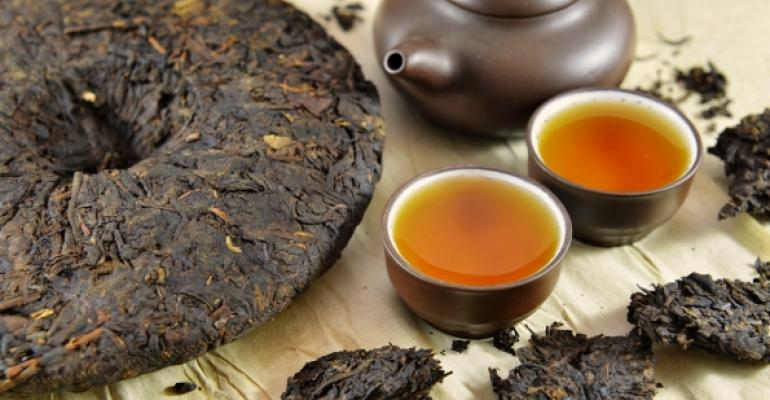No other beverage pleases in as many ways as tea. It is an iced refresher, a comforting wakeup call, a cheerful social medium, a flavoring for cuisine and cocktails and for some aficionados, a sip as complex and expressive as fine wine.
The latter niche — known variously as specialty, artisan or fine tea — is a big opportunity for restaurant operators. It is made up of fresh, expertly processed, high-end teas from noteworthy origins, along with premium herbal teas and fruit infusions, either in loose-leaf form or packed in sachets.
Specialty tea, growing by 8 percent to 10 percent annually, “continues to be the star” in the tea market, declares the State of the U.S. Tea Industry Report 2015 by the Tea Association of the U.S.A. The wholesale value of the specialty tea segment was estimated to reach $2.09 billion last year, up from $270 million in 1990.
Those higher-end teas are part of an overall foodservice tea market pegged at $20 billion and growing by a Packaged Facts report in January. The market research firm predicts that although coffee will continue to drive restaurant industry sales, tea “likely will have the edge in future growth momentum,” with sales increasing through 2018 and beyond.
Around the foodservice industry, some establishments are leveraging the growing interest in tea. Take L’Espalier, the upscale New England-French cuisine destination in Boston. “Many guests are open to, and even excited about, learning and being introduced to fine artisanal teas,” says Cynthia Gold, L’Espalier tea sommelier.
Gold curates L’Espalier’s 20-item tea collection of standout offerings, including signature house blends, single-estate teas and rare teas. She also has lent her stock in trade to the bar, where the Green Tea Gimlet is the best-selling cocktail. At weekend brunches, tea flights are an option. Moreover, tea is the focus of special food-and-tea-pairing dinners and tea-blending parties for bridal showers.
Tea is in style at Eataly Chicago, celebrity chef Mario Batali’s sprawling Italian marketplace and restaurant complex. Mint and green teas are thriving, black tea is slowing slightly and herbal teas are “kicking up a bit,” reports Sean Akers, Eataly grocery manager.
Adds Akers, "We have noticed that our guests prefer cold, ready-to-drink tea, especially as an alternative to soda.”
“Tea took a backseat to coffee for a long time,” says Christian Eck, tea specialist and event services manager at the Park Hyatt Washington hotel in the nation’s capital. “But now there is a lot of experimentation going on with tea.”
There is logic to having a fine tea selection in an upscale restaurant, Eck points out. For one thing, it gives guests another distinctive, premium beverage to choose, especially in the morning. For another, it gives a restaurant that offers fresh, high-quality food, coffee, wine and beer a tea offering of equal caliber. “Guests should have freshly sourced tea and coffee beans roasted within the past two weeks,” says Eck. “They shouldn’t be drinking things that have been sitting around for months.”
Eck oversees the Tea Cellar list at the Park Hyatt Washington, a collection of 38 unique teas and herbal teas displayed in glass vessels in the hotel lounge. Sourced from China, Japan, Sri Lanka and India, and including herbal selections from Egypt, France and Argentina, they range in price from $8 to $300 per pot.
The list is arranged progressively from lower to higher caffeine content, starting with caffeine-free herbal teas and tisanes and peaking with robust, bracing black teas. Offerings are grouped by type, such white, green, oolong and black tea, interspersed with special categories such as blooming and Pu-erh tea.
Moonlight Jasmine Blossom, a blooming tea from China, has jasmine flowers bundled into green tea leaves. They expand and unfold in hot water and release a delicate perfume. Japanese Genmaicha combines high-quality green tea and fire-toasted rice. Vintage-dated Pu-erh teas from China have a deep, complex flavor created by decades-long microbial fermentation. An example is the 1978 Vintage Reserve Cave Aged Pu-erh. Only in recent years have the Chinese allowed prized pu-erh to be exported, Eck notes.
Add to that a fine iced tea that the hotel custom-blends from two of the caffeine-free offerings: a blend of black and red currants, hibiscus, rosehips and raisins and a medley of peppery, lemony Greek mountain herbs.
“It has that light and fruity flavor that perfectly reminds you of summer, plus an herbal tinge that rounds out the flavors and gives it a little pop,” says Eck. “It’s an iced tea that is caffeine free and sugar free. Guests drink it through lunch and all day.”
The rewards can be substantial for restaurant operators who promote artisan tea, according to Marshall Malone, tea category manager for Royal Cup Coffee and Tea. “If a restaurant or café puts tea front and center and shows people that they do something special with it, tea orders go through the roof,” says Malone. “Any restaurant that is putting out a tired tea bag and tepid water is missing the boat.”
In fact, switching from a tea bag that costs pennies to an artisan tea that costs 15 or 20 cents per serving can increase profitability tenfold. “You can buy a pound of specialty tea for under $30 and generate $700 or $800 in revenue,” says Malone.





